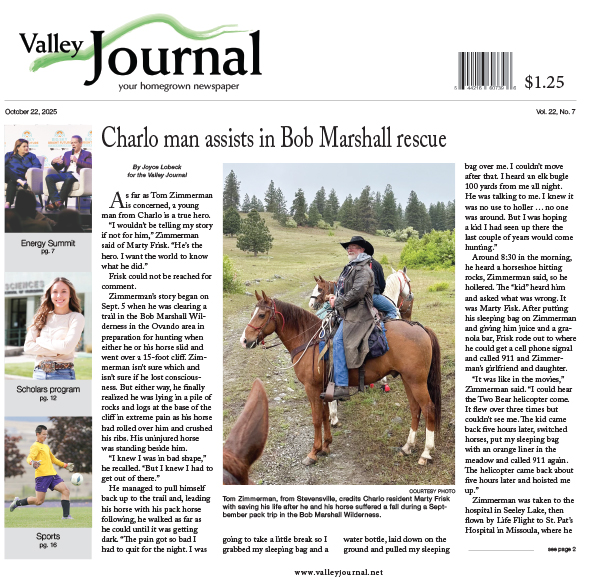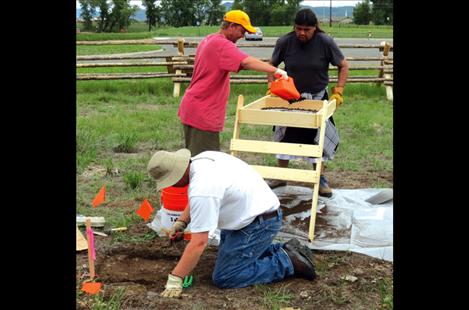Tribal Historical Preservation major only one around
Hey savvy news reader! Thanks for choosing local.
You are now reading
2 of 3 free articles.
PABLO — “I told them they were the only people in the universe to have a degree in Tribal Historic Preservation,” said Jeff Bendremer, Ph.D., director of the Tribal Historic Preservation Program at Salish Kootenai College.
Bendremer was talking about the four students who graduated with two-year Associate degrees at Salish Kootenai College’s 2013 commencement ceremonies.
That’s because there’s never been a program like the Tribal Historic Preservation major. It’s in its second year at SKC, with 26 students. That’s up from 12 in the 2012-13 school, and a dozen tribes are represented as well as non-natives. The THP major offers both an Associate of Arts and a Bachelor of Arts degree. The courses are a combination of Native American studies, Native language, anthropology and history, Bendremer said.
Student Kayla Johnson said she has always been interested in her Native American heritage and culture.
“It concerns me that so much is being lost. I want to be part of the group that’s preserving (heritage and culture) and helping to keep it alive,” she said.
Angela Iekes became interested in the major because “Jeff talked about (the Tribal Historic Preservation Program) all the time.” Iekes has been in the program for two years.
Another student, Wayne Freeman, has a design background.
“I wanted to pursue this degree and apply it to design to help preserve culture,” Freeman said, who’s also interested in landscape and architecture.
How it began
Bendremer came up with the idea for the major while Joe McDonald was still SKC president. Bendremer ran his idea past the president.
“Joe said, ‘That sounds like something you can really work on,’ and then he retired three weeks later,” Bendremer said.
McDonald got the program in the door, and since then SKC President Luanna Ross, Interim President Elaine Frank and now current President Robert DePoe were all supportive.
To fund the major, Bendremer wrote and received a three-year grant from the National Endowment of the Humanities.
SKC administration was involved, as was the curriculum committee, and department heads had to approve the new major, but “we got it created very, very quickly,” Bendremer said.
Then the major was submitted to the Northwest Commission on Colleges and Universities, SKC’s accreditation agency. The agency had to approve it, which they did after a three-month perusal.
The college created 13 new courses from scratch.
Bendremer admitted that was challenging, “Since I’m a one-person show.”
Bendremer’s background
“Well, I was brought up a straight-up archaeologist,” Bendremer said.
After earning his doctorate from the University of Connecticut, he worked for a number of tribes, including the Mohegan Tribe of Connecticut. While there he created an archeological field school, originally to provide archaeological service for the Mohegan free of charge.
“Students would basically pay to come in and do archaeology,” Bendremer said. He took a tenure track position at Indiana University, but the tribe told him they were hiring a full time archaeologist, so he applied. And that was his job until he moved to Montana.
Now the Mohegans have a big destination resort and casino and don’t need the money, but the field school is still ongoing.
SKC’s field school
The SKC program also features an indigenous archaeological field school. The main project is a partnership with the Grant-Kohrs Ranch National Historic Site, near Deer Lodge. The ranch was considering the site of the Stuart/Menard ranch house as a new, larger and more interesting point of contact for the public. The only problem was the 1880 era house, home to ranch worker families Stuart and Menard, was no longer standing.
“Our job was to find (the Stuart Menard house) and investigate it — find out what the site can tell us,” said Bendremer.
“It’s a great project for students,” Bendremer said, “because it involves non-Native objects.”
The artifacts they find, such as bits of brick and strap hinges built by a blacksmith, are not culturally sensitive or sacred.
“Most of the stuff we found was charcoal and coal, but it was just the excitement of going down another level and seeing what you could find,” Iekes said.
For more information on the Tribal Historic Preservation program, visit the SKC website or contact Bendremer.

















